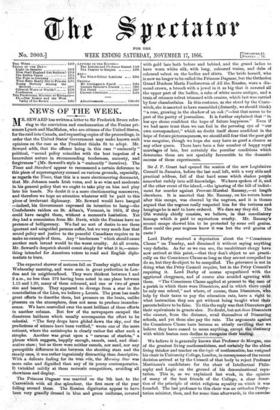The Princess Dagmar was married on the 9th inst. to
the Czarewitch with all due splendour, the first snow of the year falling around them. The Russian dignitaries appear to have been very grandly dressed in blue and green uniforms, covered with gold lace both before and behind, and the grand ladies to have worn white silk, with long, coloured trains, and dabs of coloured velvet on the bodies and skirts. The bride herself, who is now no longer to be called the Princess Dagmar, but the Orthodox Grand Duchess Maria Feodorowna of All the Russirts, wore a dia- mond crown, a brooch with a jewel in it so big that it covered all the upper part of the bodice, a robe of white moire antique, and a train of crimson velvet trimmed with ermine, which last was carried by four chamberlains. In this costume, as she stood by the Caere- witch, she is asserted to have resembled (distantly, we should think) "a rose, growing in the shadow of an oak ;"—but that seems to be part of the poetry of journalism. It is further explained that "in her eye shone confident the hope of future happiness." Even if we had more trust than we can feel in the perusing eye of "our own correspondent," which no doubt itself shone confident in the hope of future picturesqueness, we should still fear that the poor girl was sanguine, thOugh we hope she may have as good a chance as any other queen. There have been a fair number of happy royal marriages of late, but certainly the peculiar conditions which determine them are not specially favourable to the domestic. successof these experiments.






























